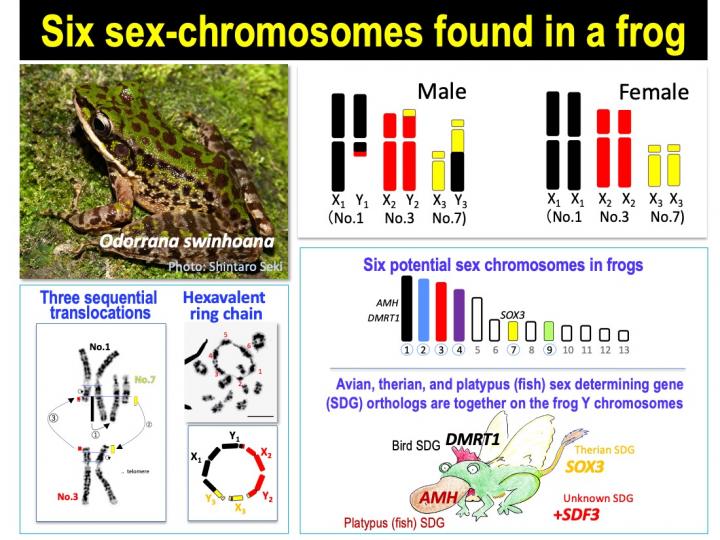The O. swinhoana frog species is the first vertebrate known to retain descendant genes that now determine sex in mammals, birds, and fishes inherited from a common ancestor

Credit: Courtesy of Ikuo Miura
Scientists found six sex chromosomes in the Odorrana swinhoana frog species endemic in Taiwan, giving new insights into how complex XY systems evolve.
The discovery was a surprise to the international research team led by Associate Professor Ikuo Miura of Hiroshima University’s Amphibian Research Center. In 1980, the first reported instance of multiple sex chromosome systems in amphibians was found in the Taiwanese brown frog Raina narina — a synonym for O. swinhoana — which had a male-specific translocation between two chromosomes. Its sex chromosomes could be described as ?X1Y1X2Y2-?X1X1X2X2.
The finding suggested that translocation — a chromosomal abnormality that happens when a chromosome breaks and its fragment fuses to another — occurred between two potential sex-determining chromosomes. At that time, however, the identification of the chromosomes involved in the translocation was uncertain.
So when the researchers set out to precisely identify the chromosomes involved, they were expecting only one translocation and not three. The three male-specific translocations created a system of six sex chromosomes, ?X1Y1X2Y2X3Y3-?X1X1X2X2X3X3. Their findings were published in the journal Cells last March 16, 2021.
A first among vertebrates
Cases of multiple chromosomes in amphibians are rare and their karyotypes, or collection of chromosomes, are generally highly conserved with little rearrangement among species. A majority are also homomorphic with undifferentiated sex chromosomes, unlike mammals and birds which have heteromorphic XY and ZW sex-determination systems. So far, there are only 10 known cases of multiple sex chromosome systems in amphibians.
What’s more, the research team uncovered that the potential sex-chromosomes involved in the translocations contained orthologs of the sex-determining genes in mammals, birds, and fishes. Orthologs are genes that evolved from an ancestral gene found in the shared ancestor of those species.
The researchers found the Dmrt1, the male determining gene in birds, and Amh, the male determining gene in fish and platypus, on the Y1 chromosome; the Sox3, the ancestral gene of SRY in therian mammals and the male determining gene in medaka fish, on the Y3 chromosome; and an unidentified sex-determining gene on the Y2 chromosome.
This is the first time that sex chromosomes containing orthologs of the sex-determining genes in mammals, birds, and fishes are found together in a vertebrate species.
Chance vs choice
Sex chromosomes evolve from an ordinary autosomal pair after acquiring a sex-determining gene. But the team has yet to figure out which of the three pairs is the original sex chromosome and which is the major sex-determining gene of the three candidates: Dmrt1, Amh, and Sox3.
Miura explained that up to now sex chromosome-autosome fusion has been documented as a chance occurrence.
“In fact, it was like that in this frog, too. The break and fusion of the chromosomes may have occurred by chance,” he said.
But the researchers believe that the chromosome members involved in the fusions were selected non-randomly or inevitably chosen as they probably share a common genomic region.
“To be so, the three may share a common DNA sequence on each of them, which makes them closely localized to each other, and this makes it possible to join the simultaneously occurring breakages and translocations.”
“This rare case suggests sex-specific, nonrandom translocations and thus provides a new viewpoint for the evolutionary meaning of the multiple sex chromosome system.”
Miura said identifying the genomic sequence common to the potential sex chromosomes would improve understanding of the mechanisms of its evolution and turnover.
###
About Hiroshima University
Since its foundation in 1949, Hiroshima University has striven to become one of the most prominent and comprehensive universities in Japan for the promotion and development of scholarship and education. Consisting of 12 schools for undergraduate level and 4 graduate schools, ranging from natural sciences to humanities and social sciences, the university has grown into one of the most distinguished comprehensive research universities in Japan. English website: https:/
Media Contact
Norifumi Miyokawa
[email protected]
Original Source
https:/
Related Journal Article
http://dx.




